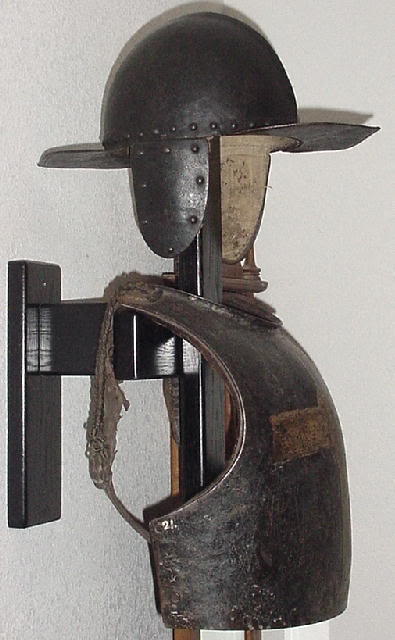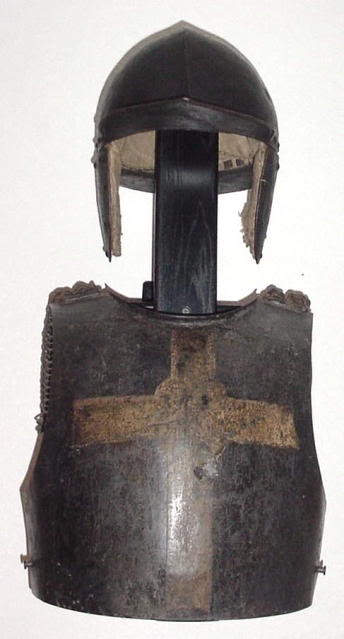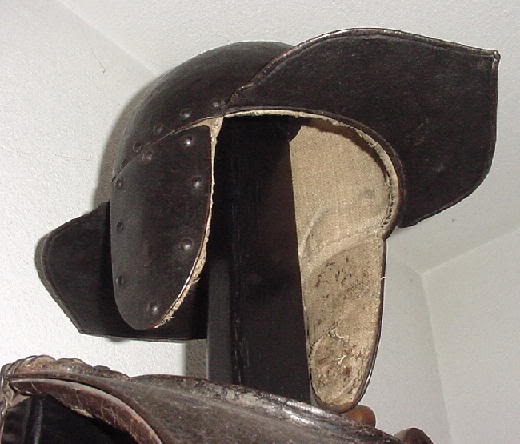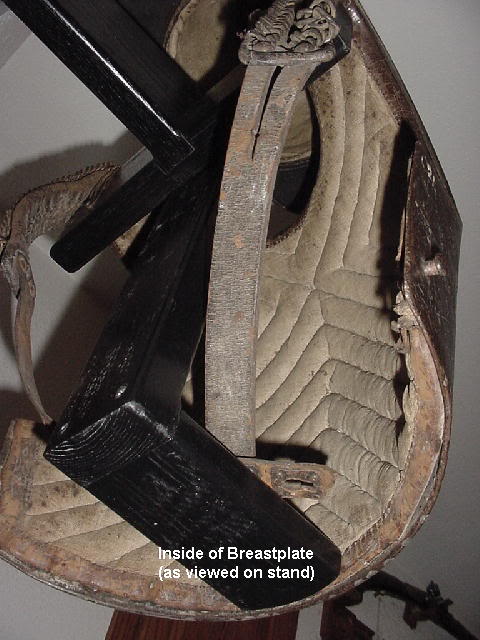| Author |
Message |
Christopher VaughnStrever

|
 Posted: Mon 28 Sep, 2009 2:19 pm Post subject: 17th century armour with orginal padding Posted: Mon 28 Sep, 2009 2:19 pm Post subject: 17th century armour with orginal padding |
 |
|
Ok here is the quote | Quote: | | both the helmet and breastplate have their original black paint and original padded linen lining. |
and here is the link to the site and pictures (I am sorry I could not post a direct link
Go to http://www.antiqueweaponstore.com/
Scroll down to "Armour" and click on "Armour"
Then scroll down to the third item titled "Rare German Siege Armour 117th C."
Thats the one to click on.
As far as I was aware the orginal padding never survived the years... Could this be a piece that could be studied and we could know a historically acurate padding actually is? Or is this some mistake???
Experience and learning from such defines maturity, not a number of age
|
|
  |
 |
Luka Borscak

|
 Posted: Mon 28 Sep, 2009 2:27 pm Post subject: Posted: Mon 28 Sep, 2009 2:27 pm Post subject: |
 |
|
Here are the pictures:




And here is the text:
Dating to the Thirty Years War, this scarce siege armour was worn by sappers (siege engineers) who worked directly under the walls of fortifications and came under intense enemy fire. It is very heavy construction, consisting of a pot helmet with front and rear visors and ear flaps, and a breastplate with shoulder straps. This is the complete armour and it was never intended to have a back plate or other elements. What makes this armour especially desirable is the fact that both the helmet and breastplate have their original black paint and original padded linen lining. The breastplate is painted with a large white cross and also features a shallow bullet test proof. The fact that the bullet did not deeply dent the armour is proof of its being extremely heavy and thick. Both pieces are in great condition for their age, the breastplate having some paint faded and flaking. The original padded leather shoulder straps are worn, with some pieces broken off (still present). One strap separated from the metal, but both sets of reinforcing chains are still present and attached. Both have some wear to lining, but the helmet is probably the best one on the market (I’ve never seen a better one). A very affordable complete and rare 17th C armour.
|
|
  |
 |
James Arlen Gillaspie
Industry Professional

Location: upstate NY Joined: 10 Nov 2005
Posts: 587
|
 Posted: Mon 28 Sep, 2009 4:45 pm Post subject: Posted: Mon 28 Sep, 2009 4:45 pm Post subject: |
 |
|
17th c. armour with its original linings is not THAT rare. I've seen a number of such items in museums and private collections, usually helmets and gauntlets. Breastplates are more rare. The Met NYC has a sallet or two with their original liners, which are late 15th c., and there are a fair number of 16th c. closehelms with their liners. Then there's the stuff at Schloss Churburg...
jamesarlen.com
|
|
   |
 |
|
Gregory J. Liebau
Location: Dinuba, CA Joined: 27 Nov 2004
Posts: 669
|
 Posted: Mon 28 Sep, 2009 4:50 pm Post subject: Posted: Mon 28 Sep, 2009 4:50 pm Post subject: |
 |
|
Churburg has a number of fine padding examples from gauntlets and helmets that date back to the 15th century. A pile of late 15th century frog helms (for the joust) with massive amounts of padding survive and are displayed in the Kunsthistorisches, Vienna, AU. A good number of 16-17th century items from across Europe have original padding in surprisingly good condition, depending on the location of the find.
-Gregory
My Flickr Galleries - Travel, Nature & Things
|
|
  |
 |
Bill Grandy
myArmoury Team


|
 Posted: Mon 28 Sep, 2009 9:15 pm Post subject: Re: 17th century armour with orginal padding Posted: Mon 28 Sep, 2009 9:15 pm Post subject: Re: 17th century armour with orginal padding |
 |
|
| Christopher VaughnStrever wrote: | | As far as I was aware the orginal padding never survived the years... |
Never say never, particularly with regards to history.  The older the armour, the less likely anything survived, but its not at all unheard of to see 17th c. organic materials (leather, cloth, etc.) The older the armour, the less likely anything survived, but its not at all unheard of to see 17th c. organic materials (leather, cloth, etc.)
| Quote: | | Could this be a piece that could be studied and we could know a historically acurate padding actually is? Or is this some mistake??? |
Doubtful its a mistake. Assuming its genuine (and I don't have any glaring reasons to doubt it, but you never know), yes, its a piece that could be studied. Its likely not a one of a kind piece, nor is it likely that unique compared to other surviving 17th c. pieces, but certainly any antique is worthwhile for study.
HistoricalHandcrafts.com
-Inspired by History, Crafted by Hand
"For practice is better than artfulness. Your exercise can do well without artfulness, but artfulness is not much good without the exercise.” -anonymous 15th century fencing master, MS 3227a
|
|
   |
 |
|
Emil S Andersen
|
 Posted: Tue 29 Sep, 2009 9:28 am Post subject: Posted: Tue 29 Sep, 2009 9:28 am Post subject: |
 |
|
|
When did they start to fit the padding directly onto the armour, instead of arming clothes?
|
|
  |
 |
|
Sean Manning
|
 Posted: Tue 29 Sep, 2009 6:44 pm Post subject: Posted: Tue 29 Sep, 2009 6:44 pm Post subject: |
 |
|
| Emil S Andersen wrote: | | When did they start to fit the padding directly onto the armour, instead of arming clothes? |
Most cultures did both, with one or the other being prefered at a given time. I suspect that 16th century infantry armour mostly had built-in padding but I'm not sure.
|
|
  |
 |
|
|

